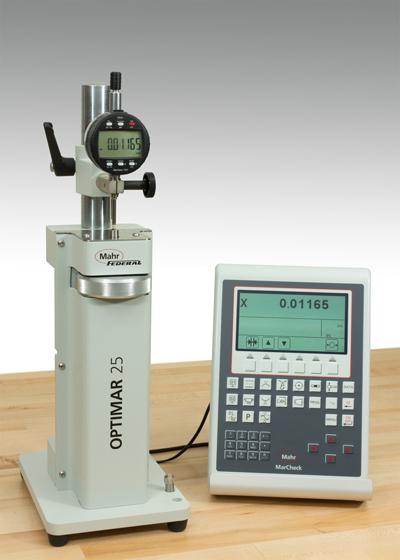
Mahr Federal has introduced a long range indicator calibrator, the OPTIMAR 25. A precision benchtop instrument, the OPTIMAR 25 can be used for the calibration of a wide variety of precision measuring instruments. Accurate to +/-10 microinches. (+/-0.3µm) over its full 0 to 1" (25mm) range, the OPTIMAR 25 Calibrator is capable of measuring to many National Standards, and comes with a large MarCheck LCD monochrome digital display with background illumination and clearly readable 13mm/0.512" high digits.
George Schuetz, Director Precision Gages for Mahr Federal, said"If you already have a quality control department that is responsible for checking parts, a long range indicator calibrator like the OPTIMAR 25 would handle all of the basic hand tools in your operation. With a set of blocks and the calibrator, you would have all the tools needed to bring outsourced calibration services in house."
The OPTIMAR 25 measures dial and digital indicators in the preferred upright position. Using a precise digital encoder, the OPTIMAR 25 measures directly in line with the instrument, with no backlash and a smooth operation. OPTIMAR 25 performs high precision calibration on a full range of measuring instruments, including dial and digital indicators; dial and digital comparators; dial and digital test indicators; electronic probes and gageheads; Air Probes and jet probes; and any other devices that magnify the linear displacement of a contact point or measuring spindle.
OPTIMAR 25 Long Range Indicator Calibrator comes standard with the MarCheck display, a MarTest mounting shaft and adapter bushing, and a MarCheck angle display stand. Also included is a Long Form Certificate of Calibration, traceable to NIST, so that you can place the gage directly into use and under your calibration control.
Gage Calibration documentation can be performed using QMSOFT's QM-DIAL software (sold separately) which is designed to support the inspection of dial gages according to the most commonly used worldwide standards. The QM-DIAL program, for example, includes modules to carry out inspection according to the German DIN standards (including the VDI/VDE/DGQ-standard), American ANSI/ASME standards, and British, Australian, Korean, Japanese and French standards. Other available options include a universal centering support, a dovetail mounting shaft, a foot switch for data transfer, and an RS232 Null Modem cable.
Contact Details
Related Glossary Terms
- backlash
backlash
Reaction in dynamic motion systems where potential energy that was created while the object was in motion is released when the object stops. Release of this potential energy or inertia causes the device to quickly snap backward relative to the last direction of motion. Backlash can cause a system’s final resting position to be different from what was intended and from where the control system intended to stop the device.
- bushing
bushing
Cylindrical sleeve, typically made from high-grade tool steel, inserted into a jig fixture to guide cutting tools. There are three main types: renewable, used in liners that in turn are installed in the jig; press-fit, installed directly in the jig for short production runs; and liner (or master), installed permanently in a jig to receive renewable bushing.
- calibration
calibration
Checking measuring instruments and devices against a master set to ensure that, over time, they have remained dimensionally stable and nominally accurate.
- centering
centering
1. Process of locating the center of a workpiece to be mounted on centers. 2. Process of mounting the workpiece concentric to the machine spindle. See centers.
- quality assurance ( quality control)
quality assurance ( quality control)
Terms denoting a formal program for monitoring product quality. The denotations are the same, but QC typically connotes a more traditional postmachining inspection system, while QA implies a more comprehensive approach, with emphasis on “total quality,” broad quality principles, statistical process control and other statistical methods.
